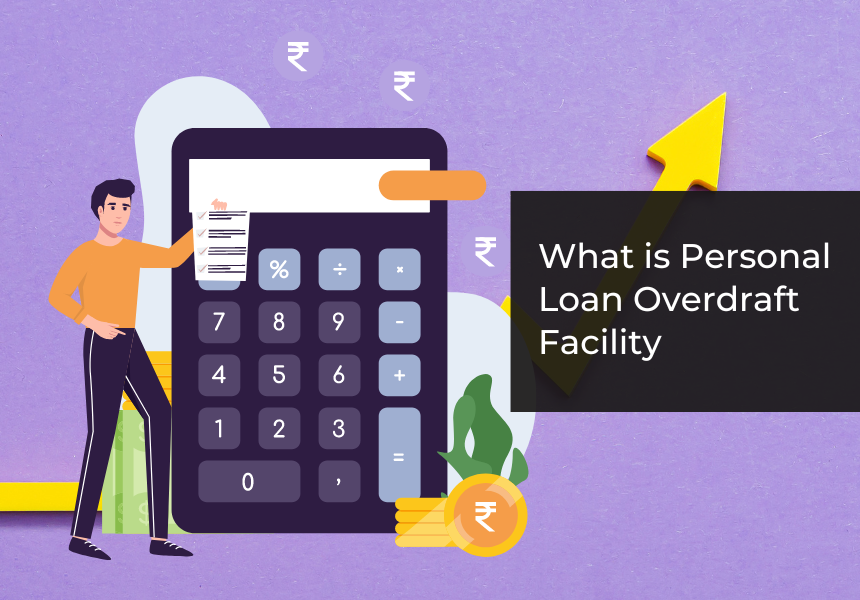Published on: September 13, 2024
Financial institutions offer several credit solutions to businesses and individuals facing fluctuating cash flow or urgent expenses. Two commonly available options are cash credit and overdraft. Although both facilities allow you to borrow beyond your immediate resources, they serve different purposes and operate on different terms.
Whether you need to finance business operations or cover personal expenses, it’s important to understand how these facilities differ and can help you manage your finances effectively.
To begin with, let’s understand the meaning of cash credit and overdraft.
What is cash flow credit?
Cash flow credit is a type of short-term loan that businesses or corporations can use to meet their immediate needs. working capital needs. It is typically used to meet unforeseen financial needs, such as purchasing raw materials or covering operational expenses. The borrower can secure this loan by pledging collateral, which can be property, financial assets like fixed deposits or shares, or even the stock of goods manufactured by the company.
A cash flow credit allows businesses to access a specific amount of funds without maintaining a credit balance, making it flexible to manage short-term cash flow issues.
Eligibility for cash flow credit depends on several factors, including the business’s credit history, type of collateral, credit score, and current assets and liabilities. This type of financing benefits small businesses that need access to capital without the need for long-term borrowing.
What is overdraft?
An overdraft is a type of financing provided by financial institutions that allows account holders to withdraw more money than is available, leading to a negative balance. Simply put, when you spend more than you have in your account, the overdraft covers the shortfall, but it must be repaid.
Financial institutions offer ease of overdraft as a type of credit. You can access a certain amount of funds beyond your available balance, and interest is only charged on the amount withdrawn. This service usually has fees and interest, so it is important to manage it carefully.
Difference between overdraft and cash credit
To make it easier for you to understand, here are the main differences between overdraft and cash credit.
| Appearance | Cash credit | Discovered |
| Aim | A cash flow loan allows businesses to meet their working capital needs. | Individuals and businesses can use overdraft facilities to cover their short-term financial needs and manage their immediate expenses. |
| Nature | Works as a revolving line of credit for businesses | Allows you to borrow beyond the available account balance |
| Interest rate | Usually comes with lower interest rates | Interest rates are higher in comparison |
| Account requirement | Requires opening a new account | Accessible via an existing account |
| Loan duration | The term may vary, but most financial institutions offer a tenure of up to 1 year. | Duration may vary depending on financial institution |
| Warranty requirements | Requires pledging assets such as inventory or inventory as collateral | This may require pledging collateral in some cases |
| Target users | Mainly used by businesses | Available for both individuals and businesses |
Things to consider when using cash credit or overdraft
Both cash credit and overdraft offer financial support, but it is important to consider several factors before choosing either option:
1. Interest rate
Compare the interest rate offered by your financial institution. Cash credit usually comes with a lower interest rate than overdraft, making it more cost-effective for long-term business needs.
2. Seizure fees
If you plan to close the credit facility before the agreed term, you may be charged a foreclosure fee ranging from 1% to 2% of the loan amount.
3. Processing Fees
You need to consider the processing fees associated with both facilities. These fees can add to the overall expense, so it’s important to take them into account when evaluating options.
4. Use of the loan
In some cases, particularly in the case of a cash flow loan, if the approved amount is not used in full, the financial institution may still charge interest on the unused portion. You should ensure that you understand the terms and conditions regarding availing the loan before opting for a facility.
5. Penalty Fees
You should check the penalty interest or fees that some financial institutions may impose for exceeding the sanctioned limit or for not complying with the agreed terms. Considering these potential fees will help you avoid unnecessary costs.
Conclusion
Although cash credit and overdraft both offer convenient means of financing, they serve different purposes. Cash flow credit is customized for businesses that need consistent working capital and has lower interest and interest rates. require a guarantee. In contrast, overdraft provides more flexibility for individuals and businesses to manage short-term financial deficits, although it often comes with higher interest rates. Understanding the differences between the two can help you choose the most appropriate option based on your financial needs.
Frequently Asked Questions
Which is more suitable for businesses, cash credit or overdraft?
Cash flow credit is generally more suitable for businesses because it allows you to manage regular operational expenses over the long term. While overdrafts are often used for temporary cash shortages. To find the facility best suited to your business, consider interest rates, repayment terms and the amount of financing required.
How is interest calculated on cash loans and overdrafts?
Whether it is a cash credit or an overdraft, interest is charged only on the amount used, not on the total limit authorized.
What type of guarantee is required for a cash loan?
Cash flow credit generally requires businesses to pledge assets such as real estate, inventory, term deposits or shares as collateral.
What factors affect approval for an overdraft facility?
Approval for an overdraft depends on factors such as the borrower’s credit score, financial situation and, sometimes, available collateral or investments.
What happens if I exceed the approved cash credit or overdraft limit?
If you exceed the authorized limit at either establishment, the financial institution may charge you a penalty or higher interest rates. It could also affect your credit score and future borrowing ability.
Related blogs

How is a personal overdraft different from a personal loan?
03/10/2024
![]()

What is personal loan overdraft facility
06/30/2023
![]()

5 things to know about the personal overdraft facility
09/20/2021
![]()